AOP
概念介绍
AOP(Aspect-oriented programming)即 面向切面的程序设计,AOP 和 OOP(Object-oriented programming)面向对象程序设计一样都是一种程序设计思想,AOP 只是 OOP 的补充和延伸,可以更方便的对业务代码进行解耦,从而提高代码质量和增加代码的可重用性。后面的篇章会结合实际案例,教会大家理解并学会使用 AOP。
AOP 并不规定必须使用某种方式来实现。
场景
我们就日志记录功能入手带领大家理解 AOP 切面编程的优势。首先假设我们有以下需求:
- 需要对某个接口做调用记录,记录接口的调用详情(调用参数,返回结果等)。
- 当调用接口出现异常时,做特殊处理,比如记录异常日志、邮件通知运维小伙伴。
如上,我们定义了一个简单的需求,接下来我们去实现它,我们先不要考虑 AOP ,就先用你所熟悉的 OOP 思想来完成以上的需求
传统 OOP 实现
现在我们有一个订单服务:
<?php declare(strict_types=1);
/**
* 订单服务
*/
class OrderService
{
/**
* 生成订单
*
* @param string $product_name 商品名字
* @param int $quantity 购买数量
* @param int $user_id 用户 ID
*
* @return array
*/
public function generateOrder($product_name, $quantity, $user_id): array
{
$price = 1000;
$amount = $price * $quantity;
$order = [
'order_no' => uniqid($user_id . time() . $amount), // 订单号
'product_name' => $product_name, // 商品名称
'price' => $price, // 商品单价
'quantity' => $quantity, // 商品数量
'amount' => $amount // 订单总额
];
return $order;
}
}
在传统的 OOP 思想下,我们要实现所需的功能,可以创建一个类继承 OrderService,然后重写 generateOrder 方法,最后在所有使用 OrderService 的地方替换成新建的类。示例:
<?php declare(strict_types=1);
/**
* Class InheritOrderService
*
*/
class InheritOrderService extends OrderService
{
/**
* @param string $product_name
* @param int $quantity
* @param int $user_id
*
* @return array
* @throws Exception
*/
public function generateOrder($product_name, $quantity, $user_id): array
{
// TODO: 记录接口调用参数
try {
$result = parent::generateOrder($product_name, $quantity, $user_id);
// TODO: 处理父方法返回结果,根据返回结果进行相关处理
return $result;
} catch (Exception $e) {
// TODO: 如有异常,记录异常日志并发送邮件,然后继续将异常抛出
throw $e;
}
}
}
最后在我们调用 OrderService 的地方,将 OrderService 替换为 InheritOrderService:
<?php declare(strict_types=1);
// $order = new OrderService(); // 注释掉旧业务调用
$order = new InheritOrderService();// 替换
$order->generateOrder('MacBook Pro', 1, 10000);
至此,经过上方的调整后,满足了我们的业务需求。现在我们回顾一下,过程似乎非常繁琐,耦合严重,甚至污染了 generateOrder 方法。如果项目中存在 100 处 OrderService 类的调用,我们就得找到这 100 个地方进行修改、替换,这就是 OOP 的思想。
这时你或许会想到使用中间件、拦截器等类似的方法来解决,其实这些方法本质上也是基于 AOP 的设计思想而来的。前文已经提到,AOP 是基于 OOP 的补充和延伸。
AOP 实现
AOP 的主要作用是在不侵入原有代码的情况下添加新的功能。
我们知道 OOP 实际上就是对我们的功能属性、方法做一个抽象封装,能够清晰的划分逻辑单元。但是 OOP 只能够进行纵向的抽象封装,无法很好的解决 横向 的重复代码,而 AOP 则很好的解决了这一问题。
请看图示:

如上图所示,我们有两个类:订单类 和 用户类,我们对其相关功能做了封装。但是,权限检查、日志记录等功能就是在重复的编码,而利用 AOP 思想就可以将这些功能 横向切 出去,然后在适当的时候再将这些功能织入进来:

这就是 AOP。
相关术语
Advice(通知)
通知是织入到目标类连接点上的一段代码,例如上方的权限检查及记录日志。
Aspect(切面)
切面由通知和切点组成,通知明确了目的,而切点明确目的地。
Introduction(引介)
引介指向一个现有类增加方法或字段属性。引介还可以在不改变现有类代码的情况下实现新的接口。
Joinpoint(连接点)
程序执行的某个特定位置,将通知放置的地方。如方法调用前、方法调用后、返回、抛出异常等。允许使用通知的地方都可称为连接点。
Pointcut(切点)
切点指需织入目标的方法。假设一个目标对象(类)中拥有 10 个方法,需要在其中 3 个方法中织入通知,这 3 个方法称为切点。
Proxy(代理)
应用通知的对象,详细内容参见设计模式里面的代理模式。代理实现了切面的业务, Swoft 使用了 PHP-Parser 库实现 AOP。
Target(目标对象)
被通知的对象类。目标含有真正的业务逻辑,可被无感知的织入。
Weaving(织入)
将切面应用至目标对象以创建新代理对象的过程。
运用声明
声明切面
通过注解 @Aspect 将类定义为切面类:
<?php declare(strict_types=1);
use Swoft\Aop\Annotation\Mapping\Aspect;
/**
* @Aspect(order=1)
*/
class DemoAspect
{
// TODO: ...
}
order:用于指定优先级,数字越小则优先执行。
声明切点
目标类必须指定为携带
namespace的完整路径或如示例代码中在顶部use。
示例代码:
<?php declare(strict_types=1);
namespace App\Aspect;
use App\Services\OrderService;
use App\Services\UserService;
use Swoft\Aop\Annotation\Mapping\Aspect;
use Swoft\Aop\Annotation\Mapping\PointAnnotation;
use Swoft\Aop\Annotation\Mapping\PointBean;
use Swoft\Aop\Annotation\Mapping\PointExecution;
use Swoft\Http\Server\Annotation\Mapping\RequestMapping;
/**
* @Aspect(order=1)
*
* @PointBean(
* include={OrderService::class,UserService::class},
* exclude={}
* )
*
* @PointAnnotation(
* include={RequestMapping::class},
* exclude={}
* )
*
* @PointExecution(
* include={OrderService::createOrder,UserService::getUserBalance},
* exclude={OrderService::generateOrder}
* )
*/
class DemoAspect
{
// TODO: ...
}
- PointBean:定义目标类切点
include:需被 指定 为切点的目标类集合exclude:需被 排除 为切点的目标类集合
- PointAnnotation:定义 注解类 切点,所有使用对应注解的方法均会通过该切面类代理
inlucde:需被 织入 的注解类集合exclude:需被 排除 的注解类集合
- PointExecution:定义确切的目标类方法。
include:需被 织入 的目标类方法集合,支持正则表达式exclude:需被 排除 的目标类方法集合,支持正则表达式
使用正则表达式时,参数内容 必须 使用双引号
" "包裹;命名空间分隔符 必须 使用\转义,同时双引号内 必须 是类的完整路径。以上注解定义的关系为并集,定义的排除为并集后的结果。建议为了便于理解和使用,一个切面类尽量只使用其中一个注解。
声明通知
<?php declare(strict_types=1);
namespace App\Aspect;
use App\Services\OrderService;
use App\Services\UserService;
use Swoft\Aop\Annotation\Mapping\After;
use Swoft\Aop\Annotation\Mapping\AfterReturning;
use Swoft\Aop\Annotation\Mapping\AfterThrowing;
use Swoft\Aop\Annotation\Mapping\Around;
use Swoft\Aop\Annotation\Mapping\Aspect;
use Swoft\Aop\Annotation\Mapping\Before;
use Swoft\Aop\Annotation\Mapping\PointExecution;
use Swoft\Aop\Point\JoinPoint;
use Swoft\Aop\Point\ProceedingJoinPoint;
use Throwable;
/**
* @Aspect(order=1)
*
* @PointExecution(
* include={OrderService::createOrder,UserService::getUserBalance},
* exclude={OrderService::generateOrder}
* )
*/
class DemoAspect
{
/**
* 前置通知
*
* @Before()
*/
public function beforeAdvice()
{
}
/**
* 后置通知
*
* @After()
*/
public function afterAdvice()
{
}
/**
* 返回通知
*
* @AfterReturning()
*
* @param JoinPoint $joinPoint
*
* @return mixed
*/
public function afterReturnAdvice(JoinPoint $joinPoint)
{
$ret = $joinPoint->getReturn();
// 返回
return $ret;
}
/**
* 异常通知
*
* @AfterThrowing()
*
* @param Throwable $throwable
*/
public function afterThrowingAdvice(Throwable $throwable)
{
}
/**
* 环绕通知
*
* @Around()
*
* @param ProceedingJoinPoint $proceedingJoinPoint
*
* @return mixed
* @throws Throwable
*/
public function aroundAdvice(ProceedingJoinPoint $proceedingJoinPoint)
{
// 前置通知
$ret = $proceedingJoinPoint->proceed();
// 后置通知
return $ret;
}
}
@Before:前置通知。在目标方法之前执行@After:后置通知。在目标方法之后执行@AfterReturing:返回通知@AfterThrowing:异常通知。目标方法异常时执行@Around:环绕通知。等同于前置通知加上后置通知,在目标方法之前及之后执行
业务示例
为了更好的理解,我们使用前置、后置通知实现一个用于计算代码执行时长的例子。
控制器
在控制器中测试更为直观:
<?php declare(strict_types=1);
namespace App\Http\Controller;
use Swoft\Http\Server\Annotation\Mapping\Controller;
use Swoft\Http\Server\Annotation\Mapping\RequestMapping;
/**
* @Controller(prefix="test")
*/
class TestRunTimeController
{
/**
* 闭包递归,计算阶乘
*
* @RequestMapping(route="factorial/{number}")
*
* @param int $number
*
* @return array
*/
public function factorial(int $number): array
{
$factorial = function ($arg) use (&$factorial) {
if ($arg == 1) {
return $arg;
}
return $arg * $factorial($arg - 1);
};
return [$factorial($number)];
}
/**
* 计算 1-1000 和,最后休眠 1s
*
* @RequestMapping(route="sum")
*/
public function sumAndSleep(): array
{
$sum = 0;
for ($i = 1; $i <= 1000; $i++) {
$sum = $sum + $i;
}
sleep(1);
return [$sum];
}
}
启动 HTTP 服务后,我们可以通过访问下方两个地址执行代码:
切面类
前文已强调,通过 AOP 我们可以在不侵入原有代码的情况下实现额外的操作。请看示例:
<?php declare(strict_types=1);
namespace App\Aspect;
use App\Http\Controller\TestRunTimeController;
use Swoft\Aop\Annotation\Mapping\After;
use Swoft\Aop\Annotation\Mapping\Aspect;
use Swoft\Aop\Annotation\Mapping\Before;
use Swoft\Aop\Annotation\Mapping\PointBean;
use Swoft\Aop\Point\JoinPoint;
/**
* @Aspect(order=1)
*
* @PointBean(include={TestRunTimeController::class})
*/
class CalculateRunTimeAspect {
/** @var float 执行开始 */
private $time_begin;
/**
* 前置通知
*
* @Before()
*/
public function beforeAdvice()
{
// 起点时间
$this->time_begin = microtime(true);
}
/**
* 后置通知
*
* @After()
*
* @param JoinPoint $joinPoint
*/
public function afterAdvice(JoinPoint $joinPoint)
{
/** @var float 执行结束 */
$timeFinish = microtime(true);
$method = $joinPoint->getMethod();
$runtime = round(($timeFinish - $this->time_begin) * 1000, 3);
echo "{$method} 方法,本次执行时间为: {$runtime}ms \n";
}
}
编写完成后重启 HTTP 服务,然后再次访问:
得到结果后返回控制台查看执行时间:
factorial 方法,本次执行时间为: 0.107ms
sumAndSleep 方法,本次执行时间为: 1000.319ms
通知执行顺序
前文已提到,多个切面按照 order 属性值进行优先级划分,数字越小优先执行。而在一个切面中的多个通知同样也按照顺序执行。
单切面
正常顺序

@Around环绕通知 前 置部分@Before前置通知- 目标对象方法
@Around环绕通知 后 置部分@After后置通知@AfterReturn返回通知
异常顺序

@Around环绕通知 前 置部分@Before前置通知- 目标对象方法
@Around环绕通知 后 置部分@After后置通知@AfterThrowing异常通知
多切面

以正常情况为例:
- 切面 1
@Around环绕通知 前 置部分 - 切面 1
@Before前置通知 - 切面 2
@Around环绕通知 前 置部分 - 切面 2
@Before前置通知 - 目标对象方法
- 切面 2
@Around环绕通知 后 置部分 - 切面 2
@After后置通知 - 切面 2
@AfterReturn返回通知 - 切面 1
@Around环绕通知 后 置通知 - 切面 1
@After后置通知 - 切面 1
@AfterReturn返回通知
注意事项
AOP 仅拦截 public 及 protected 修饰的方法,不会拦截 private 方法。
此外,在 Swoft AOP 中,如果某个方法内调用了另一个 被织入 的方法时,AOP 也会向该方法织入通知。例如我们定义了一个类 A,它有两个 public 方法 func1 和 func2,然后我们定义一个切面,使用 @PointBean(include={A::class}) 注解将 A 类(所有方法)进行织入,示例代码:
<?php
class A
{
function func1()
{
echo "func1 \n";
}
function func2()
{
$this->func1();
echo "func2 \n";
}
}
当我们执行 func2 时,我们的切面会被执行 两次,两次执行的顺序相同。切面会先对 func2 织入通知,其次对 func1 织入通知。

